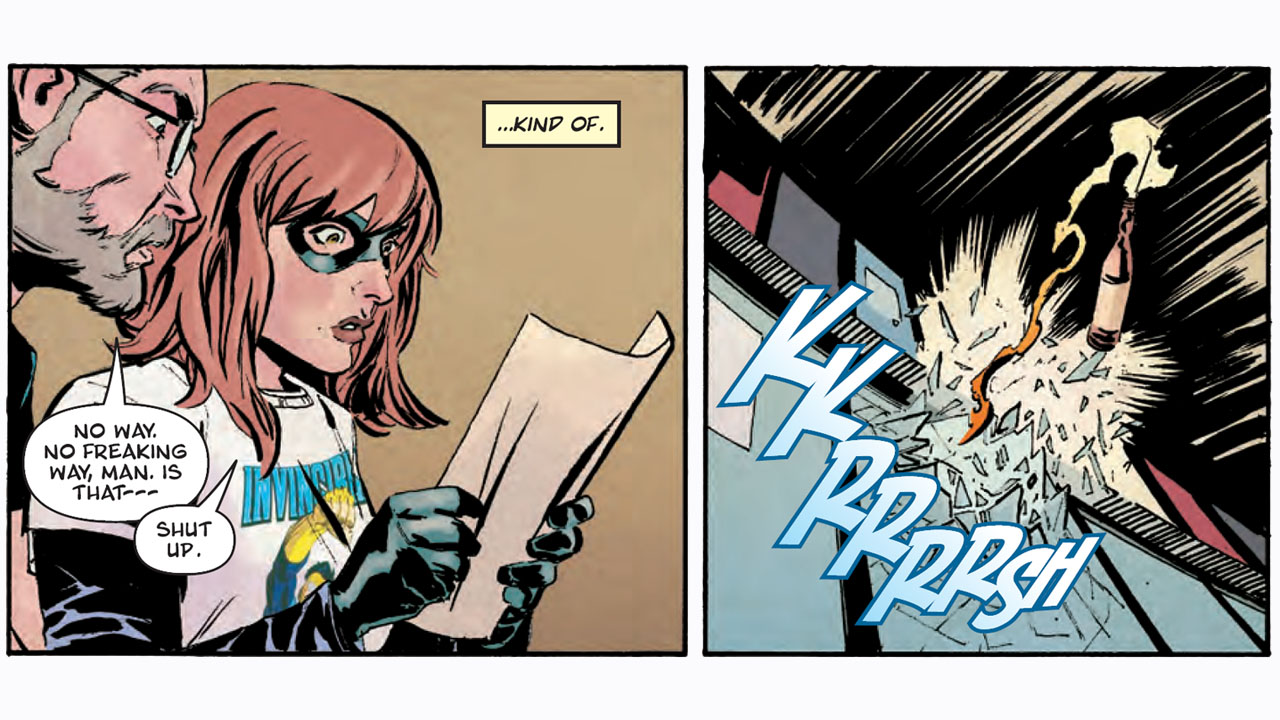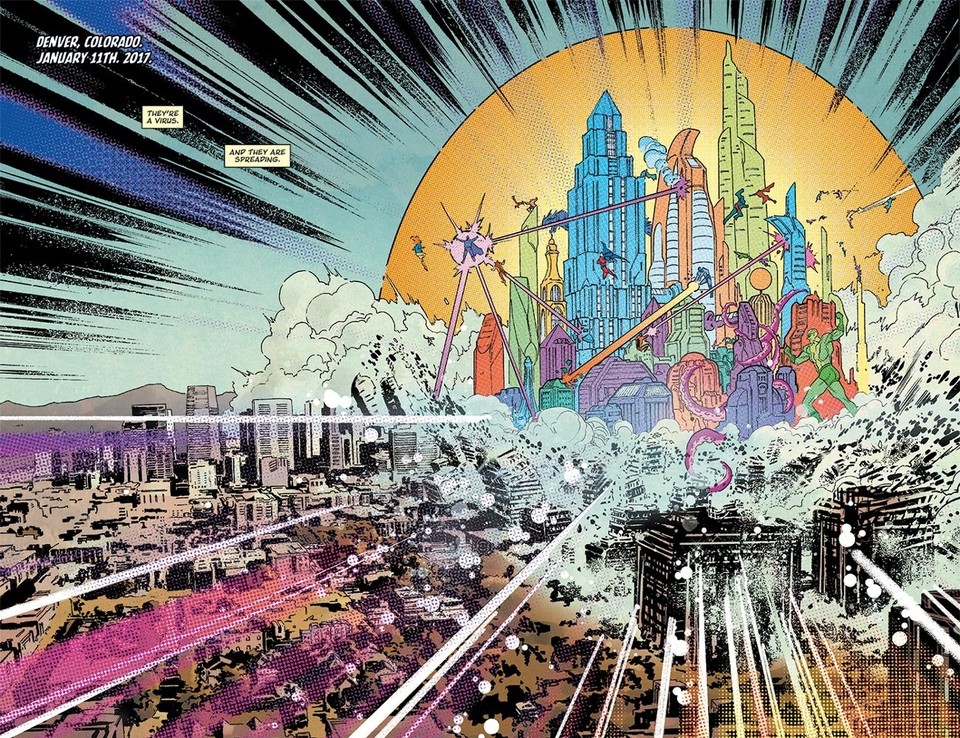Best Shots review: Crossover #1 "bold as hell" - spoilers
Donny Cates and Geoff Shaw presents "slick and provocative blockbuster" with Crossover #1

Donny Cates and Geoff Shaw get meta in Image Comics' Crossover #1, a slick and provocative blockbuster that imagines a world-ending comic book event suddenly transplanted into our present-day with catastrophic consequences.
Spoilers ahead for Crossover #1
From the first page's dueling captions between Todd McFarlane and Fredric Wertham to the final page's invocation of Superman, controversy is the order of the day here. Although artist Geoff Shaw, colorist Dee Cunniffe and letterer/designer John J. Hill present a visually arresting comic book, the tone of Donny Cates's script struggles against his insistence on placing the story firmly in the now.
Written by Donny Cates
Art by Geoff Shaw and Dee Cunniffe
Lettering and Design by John J. Hill
Published by Image Comics
'Rama Rating: 7 out of 10
Here's the pitch: In 2017, every superhero ever created suddenly manifested, mid-battle, in Denver. Countless people died in the titular Crossover before one of the heroes placed the whole state under a protective bubble. Under the bubble, the supers still fight. After the event, people who still enjoy superhero comics are highly controversial figures who are constantly under siege by hate groups. Enter comic shop worker Ellipses Howell, who dresses in cosplay and exclusively deals in pre-Crossover comics, much to the displeasure of the Christian fundamentalists who have permanently taken up a protest outside the store. Cates accurately depicts a world split apart, each side resorting to extremes and constantly provoking a reaction. From the snarky shop owner to the hate-spewing preacher, every character that Cates and Shaw have created lives for riling up its opposition.

As you can probably imagine from the synopsis, Crossover #1 is an uncomfortable book. Signs like ‘Pray the capes away' and concepts like mass hysteria against cosplay purposefully draw parallels to real-life fights for minority rights. A more charitable interpretation recalls fundamentalist groups rallying against heavy metal concerts throughout the satanic panic. However, unlike reality, the core moral panic of Crossover #1 is rooted in atrocity. Shaw and Cates make a point to show the gory fates of innocent bystanders as super-powered beings indiscriminately tear a city apart. The entire state of Colorado becomes uninhabitable. Undeniably, The Crossover was a very bad event. By evoking real-life oppression and equating it to a fictitious event of endless horror, Donny Cates has unwittingly written a story in which all that fearmongering has merit. The real-world parallels distract, adding a sense of bad taste that is impossible to shake despite the good here.
And there is a lot of good. Away from the echoes of reality, DC's legal department must have had a fun day in the office when they read this one. Superman isn't just named here. He isn't just shown. He's a major plot point. When a young girl escapes the Colorado bubble, re-emerges in Ellipses' comic shop, and claims that Superman broke her out, Cates seems to be attempting to rip Metropolis' favorite son away from Warner Bros. and into the hands of the people. It's bold as hell. Legal concepts of parody and fair use aside, Cates introduces a theme familiar to Grant Morrison fans, painting superheroes as modern myth who manifest into reality through shared belief. It's a fun little concept and one that only strengthens as the generations pass. Crossover works best when it toys with the themes of fiction-as-reality, not when it makes ham-fisted allusions to the terrors faced by marginalized communities.
Narratively, Cates has fun with comic book history here. He harkens back to the genesis of the American comic book with an undefined and omniscient narrator who proclaims the story's themes. It's solid stuff, to begin with, but it soon falls afoul of that constant need to be provocative. "Believe it or not… It's also a love story." narrates Cates, as Geoff Shaw shows us a religious extremist making doe-eyes at the comic book fan he just fire-bombed. Dialogue is clear in character and the book runs at a decent clip. Donny Cates is in the prime of his career; he knows what he's doing.

Crossover #1 preview

Geoff Shaw's art is strongly rendered throughout and with real flair. His figures are real characters, all pointy chins, and uniquely shaped noses, and he's equally at home with the large-scale stuff as it is with the intimate. In one inspired moment, McFarlane and Miller-esque talking heads, traditionally accompanied with entire paragraphs of text, are shocked into silence by the carnage of the Crossover.
Get the best comic news, insights, opinions, analysis and more!
John J. Hill letters the issue in a classically styled font, but his design work really makes the issue stand out above the pack visually. He uses twin motifs of ellipses' and CYMK blocks to bookend the issue and provide a fun alternative to the traditional "TO BE CONTINUED". Atop it all, Colorist Dee Cunniffe pairs up cinematic oranges and blues to code the good guys from the bad guys, creating a vivid book that pops.
The curse of reviewing single issues is that it is sometimes impossible to gauge a story's intent from its first part. Visually, this book is a triumph. Narratively, it is an intriguing start with questionable elements. When Cates concentrates on the superhero's impact on humanity, Crossover #1 works. When he makes an equivalence between comic book fans and marginalized people through all-too-familiar modes of protest, not so much. What exactly is Donny Cates trying to say here? From Crossover #1, it is impossible to tell.
Oscar Maltby has been writing about comics since 2015. He has also written comic book scripts for the British small press and short fiction for Ahoy Comics. He resides on the South Coast of England but lives in the longbox.



